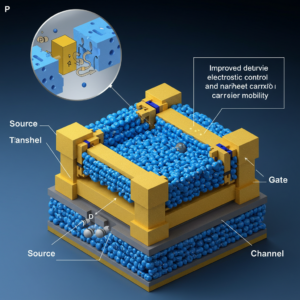The Latest Developments in Semiconductor Technology
Semiconductors are the backbone of modern technology, powering everything from smartphones to data centers and artificial intelligence. The rapid evolution of semiconductor technology continues to shape industries and economies globally. This article explores the latest advancements in semiconductor design, manufacturing, materials, and emerging trends poised to redefine the industry. KES Systems works with the technology leaders in the industry to provide world class solutions to meet the ever growing demands of semiconductor technology
1. Advances in Semiconductor Manufacturing

1.1 Extreme Ultraviolet (EUV) Lithography
EUV lithography has revolutionized semiconductor manufacturing, enabling the production of smaller and more efficient transistors. As chipmakers push beyond the 3nm node, EUV technology continues to improve with higher throughput and better defect management.
- High-NA EUV: ASML, the leading EUV equipment provider, is working on High-NA (Numerical Aperture) EUV lithography, which will enable even smaller feature sizes, critical for sub-2nm process nodes.
- Multi-patterning techniques: To further improve resolution, manufacturers are combining EUV with multi-patterning strategies, allowing for denser transistor layouts.
1.2 Gate-All-Around (GAA) Transistors

The transition from FinFET to Gate-All-Around (GAA) transistors marks a significant advancement in semiconductor design. Samsung and TSMC have already begun implementing GAA at the 3nm node, and it is expected to be widely adopted for future generations.
- Nanosheet Transistors: Unlike FinFETs, GAA transistors wrap the gate around all sides of the channel, improving electrostatic control and reducing leakage.
- Enhanced Performance & Efficiency: GAA transistors allow for better power efficiency and performance scaling, which is crucial for AI and mobile computing.

1.3 3D Packaging and Chiplet Architectures
Instead of traditional monolithic chip designs, semiconductor manufacturers are increasingly adopting chiplet architectures and advanced 3D packaging techniques to enhance performance and yield.
- TSMC’s 3DFabric and Intel’s Foveros: These packaging solutions allow for high-performance computing (HPC) applications by stacking multiple dies together.
- AMD and NVIDIA Chiplets: Both companies are leveraging chiplets to improve scalability and cost efficiency in CPUs and GPUs.
2. New Materials and Innovations in Semiconductor Fabrication
2.1 Transition to 2D Materials
As silicon scaling approaches its physical limits, researchers are exploring 2D materials such as molybdenum disulfide (MoS2) and graphene.
- Advantages: These materials offer higher electron mobility, reduced power consumption, and superior flexibility for novel applications.
- Challenges: The biggest hurdles include scalable manufacturing and integration with existing semiconductor processes.
2.2 Compound Semiconductors
Beyond silicon, compound semiconductors such as gallium nitride (GaN) and silicon carbide (SiC) are gaining traction in high-power and high-frequency applications.
- GaN in Power Electronics: GaN-based transistors are improving power efficiency in electric vehicles, data centers, and renewable energy systems.
- SiC for High Voltage: SiC is being widely adopted in the automotive industry for its superior thermal conductivity and durability in extreme conditions.
3. AI and Semiconductor Co-Design
Artificial intelligence is not only driving demand for more powerful semiconductors but also revolutionizing their design and fabrication.
3.1 AI-Driven Chip Design
Companies like Google and Synopsys are using AI to optimize chip design, reducing time-to-market and enhancing efficiency.
- Machine Learning for EDA: AI-powered Electronic Design Automation (EDA) tools are automating circuit layout and verification processes.
- Predictive Maintenance: AI is also being used in semiconductor fabs to predict equipment failures and optimize manufacturing processes.
3.2 Neuromorphic Computing

Inspired by the human brain, neuromorphic chips are designed to handle AI workloads more efficiently.
- IBM’s TrueNorth and Intel’s Loihi: These chips use spiking neural networks (SNNs) to process data with lower power consumption.
- Applications: Neuromorphic computing is expected to play a crucial role in edge AI, robotics, and real-time data processing.
4. Quantum Computing and Beyond
4.1 Superconducting Qubits vs. Silicon Qubits
Quantum computing is advancing rapidly, with different approaches being explored by industry leaders.
- IBM and Google’s Superconducting Qubits: These systems leverage superconducting materials to achieve high coherence times and faster operations.
- Intel’s Silicon Qubits: By leveraging traditional semiconductor fabrication methods, Intel is working on silicon-based qubits for easier integration with existing technology.
4.2 Cryogenic CMOS (Cryo-CMOS)
Cryogenic CMOS circuits are being developed to interface with quantum processors at extremely low temperatures.
- Key Benefits: Improved signal integrity and reduced thermal noise are crucial for scalable quantum computing architectures.
5. The Impact of Geopolitics and Supply Chain Challenges
5.1 US-China Semiconductor Rivalry
The ongoing geopolitical tensions between the US and China have significant implications for the semiconductor industry.
- Export Controls and Sanctions: The US has restricted the sale of advanced semiconductor equipment to Chinese firms like SMIC, impacting China’s chip manufacturing capabilities.
- Domestic Chip Manufacturing Initiatives: The US CHIPS Act and China’s investments in semiconductor self-sufficiency aim to reduce reliance on foreign technology.
5.2 Supply Chain Diversification
The semiconductor industry is working to mitigate supply chain disruptions by diversifying production.
- TSMC’s Expansion in the US and Japan: TSMC is building new fabs in Arizona and Kumamoto, Japan, to reduce geopolitical risks.
- Europe’s Semiconductor Push: The EU is investing in local semiconductor production to strengthen its technological independence.
6. Future Outlook and Emerging Trends
6.1 The Rise of RISC-V
RISC-V, an open-source instruction set architecture (ISA), is gaining traction as an alternative to proprietary ISAs like x86 and ARM.
- Adoption by Major Players: Companies like SiFive, Qualcomm, and even Intel are exploring RISC-V for various applications.
- Customization and Innovation: RISC-V enables flexible and cost-effective processor designs tailored for specific workloads.
6.2 Photonic and Optical Computing
Optical computing and silicon photonics promise to overcome the limitations of traditional electronic chips.
- Intel and MIT Research: Silicon photonics can significantly reduce latency and power consumption in data centers and high-performance computing.
- Quantum Communication Applications: Optical-based chips are also being investigated for secure quantum communication networks.
6.3 Next-Generation Memory Technologies
Memory technology is evolving to meet the growing demands of AI and big data applications.
- MRAM and ReRAM: These non-volatile memory solutions offer faster access speeds and lower power consumption compared to traditional NAND and DRAM.
- Compute-in-Memory: Emerging architectures aim to integrate memory and computation for more efficient AI processing.
Conclusion
The semiconductor industry is undergoing rapid transformation, driven by advancements in materials, manufacturing techniques, and AI-driven design processes. As the demand for high-performance computing, AI, and quantum technology continues to grow, innovations in semiconductor technology will play a pivotal role in shaping the future. With geopolitical shifts, supply chain restructuring, and new computing paradigms emerging, the next decade promises to be a defining era for the semiconductor industry. KES Systems continues to work with the technology leaders in the industry to provide world class solutions to meet the ever growing demands of semiconductor technology.